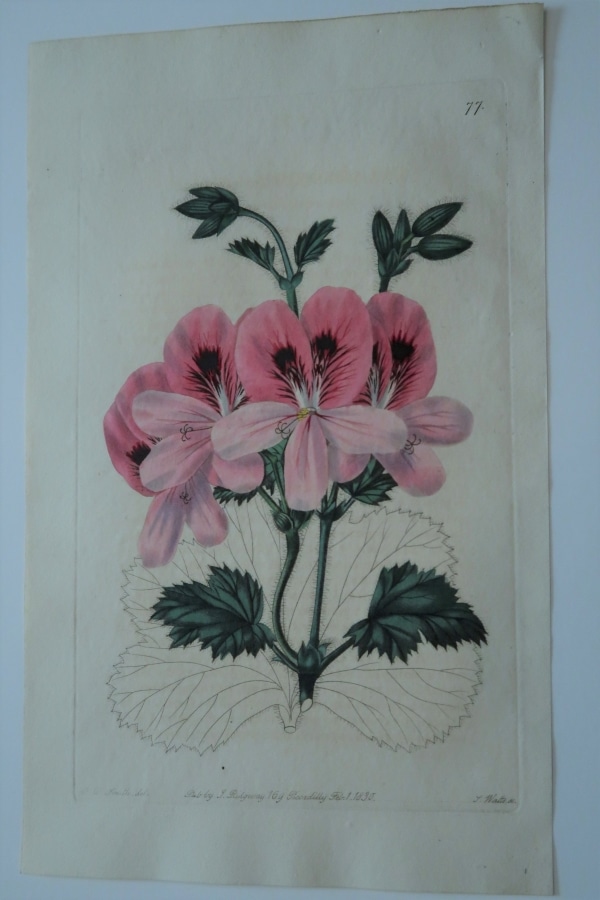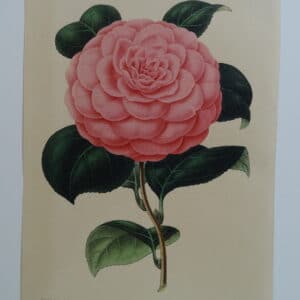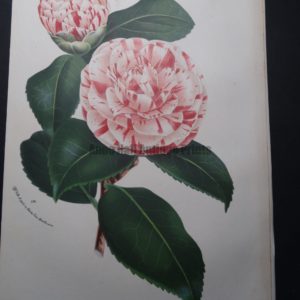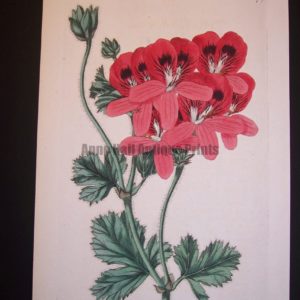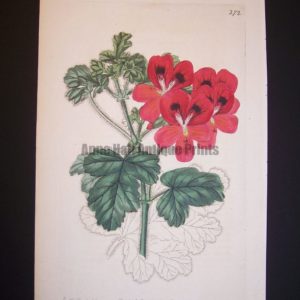Description
Geraniceae, or Genus of Pelargonium, Pink Geraniums Engraving Sweet77
Why not decorate your walls with antique prints of Geraniums family geraniceae? This rare botanical engraving from Robert Sweet’s Geraniceae, or Genus of Pelargonium. The work is considered the finest work ever published on Pelargoniums or Geraniums. This Pink Geraniums Engraving Sweet77, for Robert Sweet is an English hand-colored engraving on rag. The watercolors are intense and bright. Excellent condition for being nearly 200 years old. Each piece measures 6 x 9 1/2.”
Antique Prints and the Evolution of Printing… A quick description:
Some history behind these decorative antique prints. And a word on the printing methods used to publish them, in the 17th, 18th and 19th Centuries. My website consists of old prints, published in obsolete printing methods, that really do not exist today. The entire subject revolves about how fast information could be published for demand or readership. Readership in the old days revolved around money and new discoveries, especially in the area pertaining to natural history. If one could discover a new species of animal, fish, flower or insect… Wow! That would boost the desire for information. It had a trickle down effect. Like today, in the OLD days, desire for information lead to wanting more information. Hence the production of publishing.
First to publish religious material. Only the high priests could convey the printed messages. This lasted for a long time. Around 1800 or so, more people read. It was fashionable to be educated. So the printers had to publish more material faster, so that everyone could be on board, literally. Everyone could understand a beautiful illustration. They did not have to understand the words, but it encouraged understanding. Soon, the publications became subscriptions, everyone wanted them. Like today, everyone wants the latest devise. Initially periodical subscriptions were made to those who could afford or fund it: royalty, clergy, nobility, etc.
Who could read? The answer is only the educated, super wealthy, religious, clergy, nobility… they subscribed and read these early periodicals. It was a great pass time in the old days. Men would get together, to look at new books, discussing expeditions. Women would talk in parlors about a special flower, illustrated in a monthly magazine of gardening, and other interests and hobbies. Subjects could include information about a species of flower, that grew here or an animal that was seen there.
Oftentimes on expeditions, specimens were collected and captured, many alive, many did not survive the journeys home, nor the conditions relocated. Many journeys were three month at sea. Imaging a Giraffe, being brought from Africa to England, via a three month ship’s voyage, to arrive just barely alive, just as the ship’s crew, to Great Britain.
In the 18th and 19th Centuries museums of curiosities became the rage. Hoards of people would rush to museums to see exotic specimens brought home from expeditions of early explorers and naturalists. Royalty, Clergy financed explorations and hence the illustrations, publications that developed from trips. Often times young men, early scientists, aboard ships recorded the natural history sightings they saw along the way. They recorded every detail of the natural history specimens they came across.
All of this absolutely fascinated the public. Fortunately the recording of natural history, depicting and describing what had been found, along tremendous explorations, make these antiques unique pieces of art today. How fast the information moved forward can be seen through the history of printing. Exactly as the way things are moving forward these days, so did printing history.
In Conclusion: While it started with very slow laborious, hand drawn pages by scribes and monks onto velum, to copper plate engraving on hand made hand laid linen rag paper, and moved forward to faster and faster printing, from lithography, hand-colored or not, to printing in colors, chromolithography. All driven by readership subscriptions. It all ended about 1900. when photographic printing became the 20th century tool, to today, when everything is digital and untouchable on the internet. See all of our flora. See the geraniums page. Call Anne at 413-245-4197 or email anne@annehallantiqueprints.com.Thanks for visiting!

